
|
Warning!
At least some content in this article is derived from information featured in: Harry Potter: Hogwarts Mystery & Harry Potter: Puzzles & Spells & Harry Potter: Magic Awakened. |
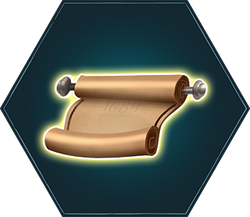
The document of this declaration
- "Upon the signature of the International Statute of Secrecy in 1689, wizards went into hiding for good. It was natural, perhaps, that they formed their own small communities within a community. Many small villages and hamlets attracted several magical families, who banded together for mutual support and protection."
- — Bathilda Bagshot, A History of Magic[src]
The International Statute of Wizarding Secrecy (also referred to as the International Code of Wizarding Secrecy[1] and commonly shortened to International Statute of Secrecy)[2] was a law in the wizarding world that was first signed in 1689,[2] then established officially in 1692.[3]
The law was laid down by the International Confederation of Wizards to safeguard the wizarding community from Muggles and hide its presence from the world at large.
History[]
Background[]
- "As the witch-hunts grew ever fiercer, wizarding families began to live double lives, using charms of concealment to protect themselves and their families. By the seventeenth century, any witch or wizard who chose to fraternise with Muggles became suspect, even an outcast in his or her own community."
- — Albus Dumbledore's notes in The Wizard and the Hopping Pot[src]
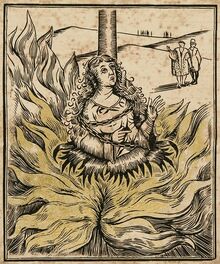
Witch-burnings and wizard persecution by Muggles in general, were a contributing factor in the introduction of the Statute
By the seventeenth century, wizard-Muggle relations were at their worst. Ever since the early fifteenth century, the persecution of witches and wizards gathered pace all over Europe, making many in the wizarding community feel, and justifiably so, that offering to aid their Muggle neighbours with their magic was tantamount to volunteering to fetch the firewood for one's own funeral pyre: many witches and wizards were locked up and sentenced to death on the charge of witchcraft.
Some (such as Lisette de Lapin in 1422) managed to use magic to escape. Witch-hunts rarely ever caught actual witches or wizards. However, some wizards like Sir Nicholas de Mimsy-Porpington in 1492 were not as lucky and were immediately stripped of their wands. Wizarding families were particularly prone to losing younger family members, whose inability to control their own magic made them noticeable, and vulnerable, to Muggle witch-hunters.[4]
Widespread persecution of wizarding children by Muggles, escalating attempts by Muggles to force witches and wizards to perform magic for Muggle ends and teach them magic, increasing numbers of witch-burnings, including those of Muggles mistakenly burned as witches, were the catalysts for some kind of measure to be taken.[5]
In Great Britain, the newly-created Ministry of Magic attempted to liaise with the Muggle British Monarch (then jointly William III and Mary II) via a special Ministry Delegation, begging them for the protection of wizards under Muggle law.[5] The failure of this attempt at official recognition and protection seems to have been the final straw that forced wizardkind to voluntarily move in the opposite direction toward secrecy.
During the 1988–1989 school year at Hogwarts, Professor Binns taught fifth-year students about the statute in History of Magic.[6]
Enactment[]
After heated discussions in the Wizengamot (during which Ralston Potter came out as a great champion of the Statute of Secrecy, as opposed to more "militant members" who voiced their desire to declare war on the Muggles),[7] the Statute was first signed in 1689,[2] but it was only three years later, in 1692,[3] that it was officially established and effectively started to be enforced by every Ministry of Magic.
The Malfoys were a wealthy and influential wizarding family who, notably, fervently opposed the imposition of the Statute. Despite their espousal of pure-blood values and their strong belief in wizards' superiority over Muggles, the Malfoys had always drawn a sharp distinction between poor Muggles and those with wealth and authority. They had historically been associated with high-born Muggle circles, such as royalty (William the Conqueror and Queen Elizabeth I being notable examples) and aristocracy. This resulted in the Malfoy's vast collection of Muggle treasures and works of art. Their strong opposition of the Statute was, in short, due to the fact that the law would force them to withdraw from this enjoyable sphere of social life.[8]
However, once the Statute was passed into law in 1692 the Malfoys cut off all ties with Muggle families. They realised that further opposition would distance them from the new heart of power: the newly created Ministry of Magic. They performed an abrupt volte-face, and became vocally supportive of the Statute, hotly denying that they had ever fraternised with such people, in spite of the ample evidence to the contrary that wizarding historians assert.[8]
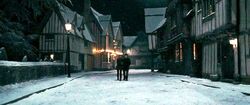
The half-magical wizard village of Godric's Hollow
Now that Muggle and wizarding societies were alienated, it seemed only natural for wizards to come together and create, as Professor Bathilda Bagshot put it on her A History of Magic, "their own small communities within a community". Several magical families were attracted to small villages and hamlets, where they could start their own communities, for mutual support and protection, alongside more tolerant and sometimes Confunded Muggles. Some of the most celebrated of these half-magical wizard villages of Tinworth in Cornwall, Upper Flagley in Yorkshire, Ottery St Catchpole in Devon, and Godric's Hollow in the West Country date back to then.[2]
Contents[]
The Statute stated that each individual Ministry or Council was responsible for hiding the presence of the magical community in their own country. Each Ministry was held responsible for, among other things, the control of magical beasts, curbing public displays of underage magic, and ensuring that magical games and sports were played without risk of discovery.
Clause 73[]
In 1750, Clause 73 was added to the Statute. The Clause stated:
- "Each wizarding governing body will be responsible for the concealment, care and control of all magical beasts, beings, and spirits dwelling within its territory's borders. Should any such creature cause harm to, or draw the notice of, the Muggle community, that nation's wizarding governing body will be subject to discipline by the International Confederation of Wizards."
- — Clause 73, International Statute of Wizarding Secrecy[src]
Dress guidelines[]
The Statute also included dress guidelines for witches and wizards when among Muggles. The Statute stated:
- "When mingling with Muggles, wizards and witches will adopt an entirely Muggle standard of dress, which will conform as closely as possible to the fashion of the day. Clothing must be appropriate to the climate, the geographical region and the occasion. Nothing self-altering or adjusting is to be worn in front of Muggles."
- — International Statute of Wizarding Secrecy[src]
In spite of these clear instructions, clothing misdemeanours were one of the most common infractions of the International Statute of Secrecy since its inception.[9] Additionally, it is implied through dialogue that the dress guidelines are somewhat relaxed during Hallowe'en, due to the Muggle tradition of wearing costumes allowing Wizarding outfits to be worn without arousing suspicion. Indeed, Voldemort himself was able to freely walk among Muggles on Hallowe'en in 1981, with his robes being dismissed as a costume.[2]
Sports rules[]
The Statute included sports guidelines when among Muggles. Wizards and witches were strictly forbidden from taking part in Muggle sports, yet they were allowed to support a Muggle side.[10]
Breaches[]
Breaches of the Statute, such as using magic in front of Muggles for no good reason, were dealt with by the relevant Ministry, with a variety of punishments available to be enforced upon the offender.
Breaches of Clause 73[]
Clause 73 was breached repeatedly, with the countries of Scotland and Tibet among the worst offenders. Scotland was home to the world's largest kelpie, which was known to the Muggle world as the Loch Ness Monster, and was the subject of repeated sightings. In Tibet, the number of Yeti sightings prompted the International Confederation of Wizards to station an International Task Force in the mountains on a permanent basis.[11]
Other breaches of Clause 73 included the Ilfracombe Incident in 1932.[11]
Originally, Isobel McGonagall followed the Statute by concealing her magical heritage from her Muggle husband, Robert McGonagall Snr. However, when their first daughter Minerva began exhibiting magical powers, Isobel was forced to break the Statute and reveal to her husband the existence of the wizarding world. This shows that wizards and witches with Muggle spouses could reveal the magical world under such circumstances. It was for this reason that Minerva refused to marry Dougal McGregor, fearing to bring up her magical heritage.[12]
When the Minister for Magic introduced him- or herself to the Muggle Prime Minister, they could use magic as proof of existence of magic, as Cornelius Fudge performed a transfiguration spell in front of the new Prime Minister as an introduction. It was expected that the Muggle Prime Minister would not tell anyone of this, seeing that probably nobody would believe it anyway, and this breach would not be considered against the law.[13]
Breaches of the sports rules[]
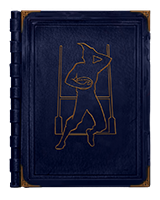
My Life as a Squib by Angus Buchanan, who played Scottish rugby
The rumoured true goal of the Wizarding Supporters of Scottish Rugby Union was to secretly install a gifted Squib on every Scottish rugby team, thus infringing the express prohibition on wizarding interference in Muggle sports set in the Statute of Secrecy. Jim Hamilton and Kelly Brown were two such suspected Squibs.
It was known that Stuart Hogg was a wizard,[14] something which, even though Muggles remain unaware of it, contravened the Statute of Secrecy.
Other breaches[]
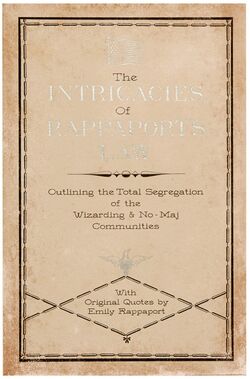
In 1790, a North American witch named Dorcus Twelvetrees made a serious breach when she confided secret information to a No-Maj Scourer descendant named Bartholomew Barebone. She told him not only about the existence of MACUSA and the International Confederation of Wizards, but also the location of Ilvermorny School. Barebone stole her wand and showed it off to the press, and called for No-Maj persecution of magical folk. Due to his actions, President Emily Rappaport of MACUSA instated "Rappaport's Law" which completely segregated witches and wizards from the No-Majs, and remained the law of the land until repealed in 1965.[15]
When Newt Scamander visited New York City in 1926 and allowed some of his magical beasts to escape, it was considered a serious breach of the Statute. In addition, he allowed a No-Maj, Jacob Kowalski, to view the creatures and even go inside his magic case.[16]
Newt and Tina Goldstein were falsely accused of breaking the Statute of Secrecy by conspiring to unleash a dangerous Obscurus from the suitcase, but they escaped execution in the Death Cell at MACUSA. In reality, there was another Obscurial (Credence Barebone) already in New York who was killing No-Majs and destroying buildings.[16]
Gellert Grindelwald disguised himself as Percival Graves in order to track down the Obscurial who was wreaking havoc on New York in 1926. He wanted to break both the Statute of Secrecy and Rappaport's Law to show the superior power of wizards over the No-Majs.[16]
On 31 October 1981, Tom Riddle appeared in Godric's Hollow without disguising himself as a Muggle on his way to kill James and Lily Potter and their son Harry Potter (although the attempt on the latter's life was ultimately unsuccessful.) However, it is unclear if this is a true breach, as the Muggles who saw him mistook his wizarding robes for a Hallowe'en costume.[2]
The following day, incidents such as shooting stars and flocks of owls, which occurred due to the gaieties that were taking place across wizarding Britain in response to Voldemort's downfall, drew the attention of the Muggle news, a fact that Minerva McGonagall noted with concern.[17]
In 1992, Dobby cast the Hover Charm at 4 Privet Drive, in the presence of several Muggles. However, as Dobby was not supposed to be there, and Harry Potter was, and he was the only registered wizard there or anywhere nearby, the British Ministry of Magic assumed that Harry did it. It is unclear whether the statute applied to house-elves, but the Ministry considered this a breach of the statute on Harry's part.[18]
In 1994, both Durmstrang, with their underwater-travelling Ship, and Beauxbatons, with their Abraxan-pulled carriage, broke the law when travelling to Hogwarts for the Triwizard Tournament[19]
On 14 December 2018, a Muggle speed camera captured blurry footage of several out-of-control riderless Nimbus 2000 broomsticks speeding on a motorway in Sydney, Australia. The Statute of Secrecy Task Force was deployed to track the rogue brooms before they were noticed by Muggle authorities.[20]
Criticism[]
During the 20th century, Carlotta Pinkstone famously campaigned for the repeal of the Statute and letting Muggles know about the existence of magic. She was imprisoned several times for breaching the Statute in front of Muggles.[21] In 1926, Gellert Grindelwald criticised the Statute of Secrecy, claiming that it protected Muggles over Wizardkind.[16]
Exceptions[]
Certain non-magical heads of state and non-magical individuals related to witches and wizards were allowed to acknowledge of the existence of the magical communities. The British Ministers for Magic, for example, revealed themselves to the Muggle Prime Minister, while Mrs Finnegan, after marrying him, revealed her nature to her husband. Parents of Muggle-born witches and wizards were also allowed to know the truth about their child's nature, as were non-magical individuals who had the guardianship of an underage wizard or witch.[13]
Behind the scenes[]
- Although it is not stated, the year the International Statute of Wizarding Secrecy was established is the same year as the occurrence of the Salem Witch Trials in which numerous people were accused of witchcraft, with nineteen hanged, which could serve as a canon staple to make the Statute validated.
- Also not stated in canon, but the year the International Statute of Wizarding Secrecy was established is the same year as the signing of the Bill of Rights in England in the real world, a civil document that established the basic rights of citizens and men in the United Kingdom.
- On Question 11 of the Grade 1 Wizards' Ordinary Magic and Basic Aptitude Test, this law is misspelled as "International Statue of Secrecy".
- It is unknown if the Voldemort controlled British Ministry of Magic followed this declaration, since Death Eaters did attack and murder Muggles during the Second Wizarding War.
Appearances[]
- Harry Potter and the Philosopher's Stone (Indirectly mentioned only)
- Harry Potter and the Philosopher's Stone (video game) (Mentioned on a Famous Wizard Card)
- Harry Potter and the Chamber of Secrets (First mentioned)
- Harry Potter and the Chamber of Secrets (film) (Mentioned only)
- Harry Potter and the Chamber of Secrets (video game) (Mentioned on a Famous Wizard Card)
- Harry Potter and the Prisoner of Azkaban (video game) (Mentioned on a Famous Wizard Card)
- Harry Potter and the Goblet of Fire (Mentioned only)
- Harry Potter and the Order of the Phoenix (Mentioned only)
- Harry Potter and the Order of the Phoenix (film) (Mentioned only)
- Harry Potter and the Order of the Phoenix (video game) (Mentioned only)
- Harry Potter and the Half-Blood Prince (Mentioned only)
- Harry Potter and the Deathly Hallows (Mentioned only)
- Fantastic Beasts and Where to Find Them: The Original Screenplay (Mentioned only)
- Fantastic Beasts and Where to Find Them (film) (Mentioned only)
- Fantastic Beasts and Where to Find Them (Mentioned only)
- Quidditch Through the Ages (Mentioned only)
- The Tales of Beedle the Bard (Mentioned only)
- Pottermore (Mentioned only)
- Wizarding World (Mentioned only)
- J. K. Rowling's official site (Mentioned only)
- Fantastic Beasts: Cases from the Wizarding World (Mentioned only)
- LEGO Dimensions (Mentioned only)
- Harry Potter: Hogwarts Mystery (Mentioned only)
- Harry Potter: Wizards Unite (First appearance)
- Harry Potter: Puzzles & Spells (Mentioned only)
- Harry Potter: Magic Awakened (Mentioned only)
Notes and references[]
- ↑ Harry Potter and the Goblet of Fire, Chapter 26 (The Second Task)
- ↑ 2.0 2.1 2.2 2.3 2.4 2.5 Harry Potter and the Deathly Hallows, Chapter 16 (Godric's Hollow)
- ↑ 3.0 3.1 Quidditch Through the Ages, Chapter 5 (Anti-Muggle Precautions)
- ↑ The Tales of Beedle the Bard - Albus Dumbledore on "The Wizard and the Hopping Pot"
- ↑ 5.0 5.1 First question of the Third W.O.M.B.A.T. at J. K. Rowling's official site.
- ↑ Harry Potter: Hogwarts Mystery, Year 5, Chapter 15 (Secrets and Lies) - History of Magic Lesson "International Statute of Secrecy"
- ↑ Writing by J. K. Rowling: "The Potter Family" at Wizarding World
- ↑ 8.0 8.1 Writing by J. K. Rowling: "The Malfoy Family" at Wizarding World
- ↑ Writing by J. K. Rowling: "Clothing" at Wizarding World
- ↑ Writing by J. K. Rowling: "Scottish Rugby" at Wizarding World
- ↑ 11.0 11.1 Fantastic Beasts and Where to Find Them
- ↑ Writing by J. K. Rowling: "Professor McGonagall" at Wizarding World
- ↑ 13.0 13.1 Harry Potter and the Half-Blood Prince, Chapter 1 (The Other Minister)
- ↑ J.K. Rowling (@jk_rowling) on Twitter: "That thing where I said Stuart Hogg might be a Squib? He's a wizard."
- ↑ History of Magic in North America
- ↑ 16.0 16.1 16.2 16.3 Fantastic Beasts and Where to Find Them: The Original Screenplay
- ↑ Harry Potter and the Philosopher's Stone, Chapter 1
- ↑ Harry Potter and the Chamber of Secrets, Chapter 2
- ↑ Wizards' Ordinary Magic and Basic Aptitude Test: Question 11, Grade 1
- ↑ Harry Potter: Wizards Unite: Wizarding News: "Riderless Nimbus 2000 Out of Control"
- ↑ J. K. Rowling's official site
